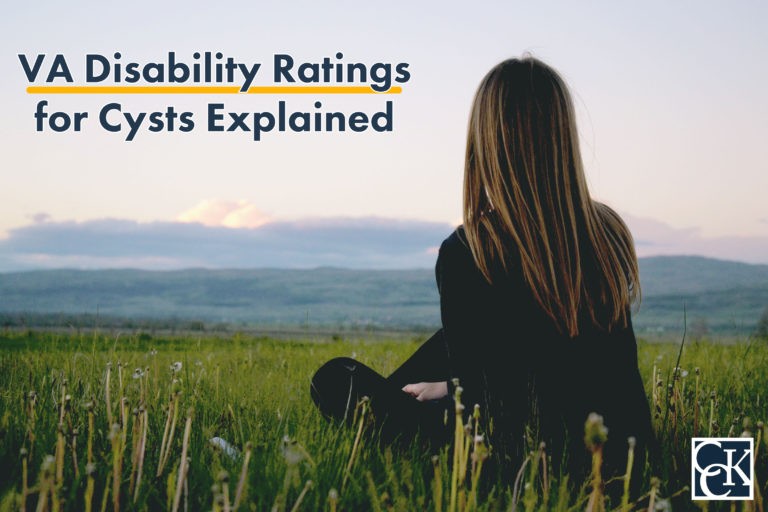VA Disability Ratings for Cysts Explained

CCK Law: Our Vital Role in Veterans Law
What are Cysts?
Cysts are abnormal sacs or bulges, often containing fluid, that can form in the skin or in the body. Although there are many different types, most are not cancerous. Most frequently, cysts can be found in the skin, ovaries, breasts, and kidneys.
Forms of Cysts
Ganglion Cysts
Ganglion cysts occur along with the tendons or joints of the wrists or hands. They can also develop around the ankles or feet. This type of cyst can be painful when it presses on nearby nerves. Sometimes, it can even interfere with joint movement.
The symptoms of ganglion cysts are often categorized by the cyst itself—specifically, where it is located, how large it is, and what shape it is. Often, these are painless, however, even small cysts can press on nerves and cause pain, numbness, and muscle weakness.
There is no specific, identifiable cause of ganglion cysts, but there are several risk factors. Ganglion cysts are most common in women, specifically between the ages of 20 and 40. At increased risk are people who experience osteoarthritis or joint and tendon injuries.
Pilonidal Cysts
Pilonidal cysts occur in the buttocks, usually near the tailbone at the top of the left buttocks. These are abnormal bumps, or pockets, which often contain hair and skin cell debris. Pilonidal cysts can also be filled with pus or blood and may produce a foul smell when drained. Symptoms also include pain and reddening of the skin.
Loose hairs, which can penetrate the skin, are one of the presumed causes of pilonidal cysts. The combination of friction and pressure is what often causes these hairs to penetrate the skin. Examples of activities that can cause this combination of friction and pressure include wearing tight clothing, sitting for long periods of time, or bicycling.
Unlike ganglion cysts, pilonidal are more common in younger males, usually men in their 20s. Other factors can contribute to the likelihood of developing pilonidal cysts, such as obesity, excessive body hair that is often stiff or coarse, or an inactive lifestyle.
It is important to seek proper medical treatment, as individuals who have pilonidal cysts that have not been treated may be at an increased risk for squamous cell carcinoma, a form of skin cancer.
Ovarian Cysts
Ovarian cysts are sacs or pockets that are filled with fluid. The ovaries are primary female reproductive organs that stem from the uterus. Women typically have two ovaries, which are roughly 3-5 centimeters or the size of a grape.
Ovarian cysts are common and often are harmless and painless. Cysts that are harmless and do not cause pain usually end up going away on their own. However, when they rupture, these can be very serious. Large ovarian cysts can cause bloating, pelvic pain, or a feeling of heaviness in the abdomen. Severe abdominal pain, coupled with a fever or vomiting, could be a sign to seek medical attention immediately.
There are different forms of ovarian cysts. Functional cysts can be caused by the menstrual cycle. Follicles are structures that the ovaries produce every month during the menstrual cycle. Follicles produce hormones, specifically estrogen and progesterone, and release an egg during ovulation. If the monthly follicles continue to grow more than normal, it can become a functional cyst.
Below are descriptions of functional cysts, meaning they can occur as a result of the menstrual cycle:
- Follicular– Follicular cysts happen midway through the menstrual cycle. They occur when the egg bursts out of the follicle and travels through the fallopian tube. The cyst develops when the follicle does not release the egg, but instead continues to grow.
- Corpus Luteum– Once the follicle releases the egg, it then produces estrogen and progesterone. The follicle, which is referred to as the corpus luteum once the egg has been released, can grow into a cyst if a surplus of fluid accumulates inside it.
Some cysts can form in the ovaries that do not occur as a result of the menstrual cycle.
- Dermoid– Dermoid cysts, also referred to as teratomas, form from embryonic cells. They can contain hair, skin, or even teeth because they contain tissue from the embryonic cells.
- Cystadenomas – These can form on the surface of one of the ovaries. Cystadenomas might be filled with a liquid, such as mucous.
- Endometriomas – Endometriosis is a condition where the uterine endometrial cells grow outside of the uterus. Endometriomas can occur as a result of endometriosis, as tissue can attach to the outside of the ovary and form a growth.
There are certain factors that can contribute to the risk of developing ovarian cysts. Some factors include endometriosis, pregnancy, pelvic infection, or having had previous ovarian cysts. Generally, ovarian cysts can cause discomfort, bloating, vomiting, nausea, painful intercourse, breast tenderness, or pelvic pain.
Service Connection for VA Service Connection for Cysts
In order to establish service connection for cysts, the veteran will need to show that it developed during service. Sometimes ovarian cysts can be misdiagnosed as premenstrual syndrome during service. If a veteran had their ovarian cysts misdiagnosed as premenstrual syndrome, they can file a claim for benefits even after their service.
As with other claims, a claim for cysts will usually require three elements:
- A diagnosis of cysts is noted in the veteran’s medical record.
- A description of how the veteran’s service contributed to or caused the cysts. Specifically for ovarian, the veteran should establish how the service contributed to or caused gynecological issues.
- A medical nexus linking the current, diagnosed cysts to service.
Secondary Service Connection
Veterans who develop conditions as a result of their cysts can also file for secondary service connection. An example of a secondary condition stemming from ovarian cysts might be if it ruptured, causing internal bleeding or sepsis. The veteran may then be entitled to compensation because the secondary condition was then caused by the primary condition. In order to be compensated for the secondary condition, the veteran would need to:
- Already be service-connected for cysts;
- Provide a diagnosis for the secondary condition;
- Provide medical evidence, or a nexus, showing the relationship between the cyst(s) and the secondary condition.

VA Disability Ratings for Cysts
VA ratings for cysts vary, depending on if the veteran needs treatment for them. VA’s breakdown of ratings is as follows:
- 0% – This rating is assigned to veterans who may have a cyst that does not require treatment.
- 10% – Veterans may receive a 10 percent rating if they required treatment for cysts at one time, but do not need continuous treatment.
- 30% – The 30 percent rating is assigned to veterans who have cysts that have produced symptoms that cannot be controlled by medication or lifestyle choices.
Additionally, VA offers special monthly compensation for veterans who face functional loss of an organ or body part. With ovarian cysts, a veteran’s ovaries may become non-functional or may require the veteran to undergo a hysterectomy. A hysterectomy is the removal of the uterus, where one or both of the ovaries could be removed. If complications from an ovarian cyst require the removal of one or both ovaries, then the veteran may be eligible for special monthly compensation based on functional loss of an organ or body part.
Compensation and Pension (C&P) Exams for Cysts
VA may request that the veteran attend a Compensation and Pension exam for their cysts. Compensation and Pension exams, or C&P exams, are generally used to collect more information regarding a veteran’s claimed condition. If VA rules in favor of service connection for the veteran’s claimed condition, the exam may additionally be used to determine what rating the veteran receives. The rating will correspond to how much compensation the veteran will receive.
Importantly, VA does not require examinations for every claimed condition. Usually, VA will send the veteran a letter requesting an examination. It is very important that the veteran follows up with scheduling the exam, as VA can deny a veteran’s claim if they do not attend the examination.
The exam will be performed by a VA medical practitioner or a VA-contracted medical practitioner. Prior to the exam, the examiner will usually review the veteran’s claims file. The claims file contains medical treatment records and evidence that has been submitted to VA previously. The claims file typically also includes the veteran’s service records.
For ovarian cysts, the examiner may perform a gynecological exam on the veteran. This is typically so that the examiner may look at other symptoms or complications that are stemming from the ovarian cyst.
In addition to the physical exam, the examiner may also ask questions regarding the cyst, any claimed secondary conditions, or their relation to service. Usually, these questions come from the Disability Benefits Questionnaire. The questions on the Disability Benefits Questionnaire (DBQ) are intended to give the veteran an opportunity to speak on their condition, symptoms, severity, and relation to other conditions.
After the C&P exam, the examiner will issue an opinion. The opinion will either be favorable or unfavorable. A favorable opinion will support the notion that the veteran’s cysts are related to service, while an unfavorable opinion will not support service connection.
If the veteran receives a negative opinion, they can obtain a second opinion to refute the VA examiner’s opinion. A medical expert can provide a second opinion.
Was Your VA Disability Claim Denied?
If your VA claim for cysts was denied, the experienced and accredited VA disability attorneys and advocates at Chisholm, Chisholm & Kilpatrick may be able to help. Contact our office at 800-544-9144 for a free case review to see if we can assist.
About the Author
Share this Post


